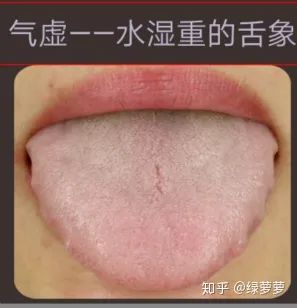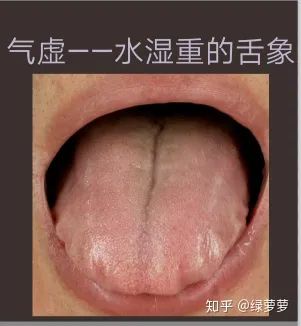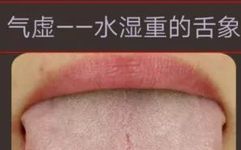The previous two articles discussed the tongue manifestations and care methods for blood stasis constitution. Today, we will talk about qi deficiency constitution.
The main symptoms of qi deficiency constitution include: shortness of breath, reluctance to speak, fatigue, dizziness, spontaneous sweating, pale complexion, and easy shortness of breath.
Qi is full when the body is strong, and qi is deficient when the body is weak; this is the norm, while the opposite indicates illness. — Huangdi Neijing
Qi Deficiency — Tongue Manifestations of Dampness
1. The tongue coating is thick; the thicker the coating, the heavier the internal dampness;
2. There are indentations on the sides of the tongue;
3. The tongue body is enlarged;

4. Individuals who often feel pent-up emotions may have two salivary glands visible;
5. A crack in the middle of the tongue indicates insufficient central qi;

Causes of Heavy Dampness:
1. Lack of physical exercise;
2. Chronic illness leading to physical weakness and excessive fatigue;
3. Exposure to cold, consumption of cold drinks harming spleen yang; air conditioning harming yang qi;
4. Incorrect drinking methods (e.g., drinking eight glasses of water a day);
5. Environmental influences;
Correction Methods:
1. Find a suitable exercise method for yourself;
2. Reduce screen time; excessive phone use depletes vital qi, so rest your eyes;
3. Avoid cold environments, minimize air conditioning use, and reduce cold drink consumption;
4. Excessive water intake can cloud the mind; some people drink cold water upon waking or excessively consume tea;
5. During damp and hot seasons, use 30 grams of Yi Yi Ren (Job’s Tears), 30 grams of Chi Xiao Dou (Adzuki Beans), and 15 grams of Dong Gua Pi (Winter Melon Skin) to brew tea;
6. When cooking, add a little Bai Dou Kou (White Cardamom), Sha Ren (Amomum Fruit), and Hua Jiao (Sichuan Pepper) to warm the stomach and dry dampness;
7. You can use several grains of Hua Jiao to brew water for foot baths to dry dampness and warm yang.

Formulas for Regulation:
1. Regulation for Excess Dampness Rising
Ling Gui Zhu Gan Tang: Warms yang, transforms phlegm, strengthens the spleen, and resolves dampness; regulates phlegm-dampness rising due to insufficient central yang. Symptoms include fullness in the chest and flanks, dizziness, palpitations, shortness of breath, white and slippery tongue coating, and wiry or slippery pulse.
Ingredients: 30 grams of Fu Ling (Poria), 9 grams of Gui Zhi (Cinnamon Twig), 9 grams of Bai Zhu (White Atractylodes), and 6 grams of Zhi Gan Cao (Honey-Fried Licorice).
2. Regulation for Dampness and Stasis Obstructing the Lower Jiao
Wu Ling San: Promotes urination, drains dampness, warms yang, and transforms qi; treats water retention due to bladder dysfunction. Symptoms include difficulty urinating, mild headache, thirst, vomiting after drinking, palpitations below the navel, dizziness, shortness of breath, or edema and diarrhea. Tongue coating is white, pulse is floating or rapid.
Ingredients: 15 grams each of Zhu Ling (Polyporus), Fu Ling (Poria), Bai Zhu (White Atractylodes), 3 grams of Ze Xie (Alisma), and 6 grams of Gui Zhi (Cinnamon Twig).
3. Regulation for Dampness Obstructing the Spleen
Ping Wei San: Dries dampness, regulates the spleen, moves qi, and harmonizes the stomach; treats damp stagnation in the spleen and stomach, with symptoms of abdominal distension, loss of appetite, bland taste, nausea, vomiting, belching, heaviness in the limbs, lethargy, and frequent diarrhea. Tongue coating is thick and greasy, pulse is slow.
Ingredients: Cang Zhu (Atractylodes), Hou Po (Magnolia Bark), Chen Pi (Tangerine Peel), and Zhi Gan Cao (Honey-Fried Licorice) (available as a patent medicine).
4. San Ren Tang for Dampness Removal: Suitable for a thick tongue coating, but with a red tongue body and indentations.
Ingredients: 6 grams of Xing Ren (Apricot Kernel), 30 grams of Yi Yi Ren (Job’s Tears), 6 grams of Dou Kou (Cardamom), 20 grams of Fu Ling (Poria), 6-9 grams of Bai Zhu (White Atractylodes), 6-9 grams of Zhu Ling (Polyporus), 3 grams of Ban Xia (Pinellia), and 6 grams of Gan Cao (Licorice).
If the person has insufficient yang qi, add 3 grams of Gui Zhi; if there is internal heat, add 3-6 grams of Zhu Ye (Bamboo Leaf).
It is recommended to use the above formulas for foot baths.
Classic Spleen Tonifying Formulas for Qi Deficiency Constitution
1. 90 grams of Huai Shan Yao (Chinese Yam), 150 grams of Yi Yi Ren (Job’s Tears), and 30 grams of Qian Shi (Euryale Seed).
Grind the above herbs into powder, take one spoonful daily, and cook with millet to make porridge. Consistent use for one month will have significant effects on spleen tonification.
2. Adults can take Ba Zhen Fen (Eight Treasure Powder) long-term.
3. Ren Mai Yin: 3 grams of Ren Shen (Ginseng) and 3 grams of Mai Dong (Ophiopogon) brewed in water. Adding Wu Wei Zi (Schisandra) makes it Sheng Mai Yin.
4. Bu Zhong Yi Qi Tang: If a person has qi deficiency, the main treatment is to tonify the spleen, which can be divided into tonifying spleen yin and tonifying spleen yang. Bu Zhong Yi Qi Wan is for tonifying spleen yang, based on the Si Jun Zi Tang (Four Gentlemen Decoction).
For general qi tonification: use Si Jun Zi Tang + Sha Ren (Amomum Fruit) + Chen Pi (Tangerine Peel).
5. Medicinal Cuisine: Black Chicken Soup with Ginseng and Astragalus.
Ingredients: 1 black chicken, 10 grams of Ren Shen (Ginseng), 30 grams of Huang Qi (Astragalus), 50 grams of Huai Shan Yao (Chinese Yam), and a piece of ginger.
Preparation: Stuff the ginseng, astragalus, and yam into the black chicken, add ginger, and steam for 3 hours.
Not suitable for: individuals with yin deficiency, heat signs, or acne.
Pregnant women must use medications under the guidance of a physician; this is very important.
Disclaimer: The above methods, formulas, and opinions are personal lecture notes for reference only. Please consult a local TCM doctor for diagnosis and treatment. The publisher is not responsible for any deviations during the regulation process.

– END –
Related Articles
Care Methods for Blood Stasis Constitution
How to Differentiate Constitution from Tongue Manifestations — Blood Stasis Constitution

